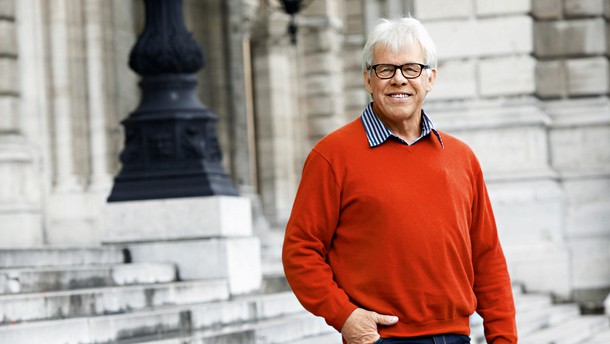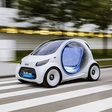
Endorsed by a Dutch traffic psychologist, Pieter de Haan, the "shared space" concept (also called a "system of naked streets" by the experts, which in practice means a shared surface for everybody who takes part in the traffic), has very much changed the idea behind public space design. We caught up with de Haan in Vienna, where he appeared as a guest speaker at the Walk21 conference, in the company of his students from the NHL University of Applied Science.
Why the concept of shared surfaces, what are their advantages?
When we create a designated space for pedestrians, cyclists and cars, people rely on traffic signs, rather than communicating with each other. They don't have to employ their minds, instead they communicate with the system. If, right now, every individual in traffic is occupied with his or her rights and rules, then these will no longer exist in the face of the "shared traffic space" concept, which will introduce equality among all traffic participants. Why should drivers have more rights and space than those who travel by foot? The current legislation and fine enforcement irritates people, and that is not right. People should be rewarded for their behaviour, which is doable only when cars travel at a low speed. Then you make the cars reduce their speed, due to a particular road setup, people start to communicate because they have to. The municipality of Drachten, which was among the first cities to employ the shared space concept, has seen a decrease from eight accidents per year to one. This concept is founded on respect, not traffic rules. What better than a pedestrian who showers you with smiles, for having brought your car to a halt and let him cross the street? Like I always say, by creating roads, all you get is cars, while by creating streets, you get people.
Aside from the shared traffic space, what is your plan to calm traffic?
We tried to change people's mentality for years, but with no results. So instead we decided to transform the environment. One of the options, for instance, is densely-planted trees along the side of the road. It's a visual illusion that tricks people into thinking they're driving faster than they really are. And it works. In the countryside, a practice that has proved efficient is weaving roads through villages, past houses in a zig-zag pattern, and not in a straight line, wherein you can see your destination and accelerate accordingly. This way, you have a feeling that you've actually entered and left the village, as opposed to driving past it in a straight line.

"I own neither a road, nor a public space, I am here only as a visitor. Public space belongs to all of us, and we all have the same rights."
In Europe, has the system of shared traffic space been received with support, or have you encountered difficulties along the way?
I think that the European Union will back up our system, simply because it improves safety. Some of the streets running through the capital cities have already taken a different shape, like the Mariahilfer strasse in Vienna and Slovenska cesta in Ljubljana. The traffic there is much slower, and subsequently safer. The trend is to close off the city centers to traffic, which results in people having to use other means of transportation to arrive at their destination. That, among others, increases the usage of urban electric vehicles, such as kick or motorized scooters, as well as the usage of public transportation.
Are cities ready for autonomous vehicles?
Driving an autonomous vehicle through the city center can be quite difficult. It's much easier once you're out of the city, when the car assumes more functions. There's more traffic in the cities, more unpredictable situations, all of which call for numerous adaptations that require time, money and, above all, political willpower. You have to tackle things one step at a time, not getting ahead of yourself. For that reason, autonomous cars should first master the highways and roads outside cities, and only once that system has been perfected, can we move on.
What about autonomous cars and the concept of a shared traffic space?
That may be a problem, considering that shared traffic surfaces thrive on communication. I cannot imagine pedestrians communicating with a vehicle that is not operated by a human. It is therefore necessary that the autonomous cars also feature a system of pedestrian, cyclist recognition... Some of them already have it.
Do you think people will have confidence in autonomous cars? Will they let them drive their children to school?
They must feel safe, they will have to have faith in the words of those who will initially test these vehicles, and they will have to take it for a test drive themselves and, little by little, they will grow confident. Of course, that is not going to happen overnight. The same applies to other new urban means of transportations. People need time.

Imagine that you are going for a night out, you've had a few drinks too many and then the car brings you safely back home. Will people take advantage of that?
Could be. The car didn't drink. That never occurred to me. [laughs]
Autonomous cars often prompt the question of whose fault it is, should an accident occur? Is it the driver or the car manufacturer? What is your take on that?
Situations of that nature must be regulated by law as soon as possible. It has long been the case, in the Netherlands, that the strongest link in traffic is responsible for the weakest link, which means that the driver is, by default, reponsible should there be an accident. That, however, cannot be applied to autonomous cars, so it's necessary that we clearly and lawfully determine who takes responibility on their behalf. In absence of a technical error, the driver could bear the responsibility, but if an accident results from a technical error, then the car manufacturer should be liable. This is an area that will require a lot of work.
Are electric cars the answer to the problem only when it comes to nature, or also when it comes to traffic?
While electric cars, their production as well as their use, are without a doubt environment-friendly. I see these autonomous vehicles as more appropriate for the car sharing system. The fact is that, nearly 90% of the time, all cars are parked without serving a purpose, which is the reason I would include them in the car sharing system. Instead of picking it up yourself, you can order an autonomous car to drive to your home, via an application. This is where I see the future.
Green mobility. What does that mean?
It is very unlikely that we'd be willing to give up cars completely, that's nearly impossible. It is also very unlikely that everybody will drive electric vehicles, though we've seen an increase in their use. For me, green mobility implies car drivers who feel as though they are visiting the city. I own neither a road, nor a public space, I am here only as a visitor. Public space belongs to all of us, and we all have the same rights. Of course, I support the use of bicycles and the bicycle sharing systems that have been growing across Europe. Here, in The Netherlands, we don't need that, because pretty much everybody owns a bike. And not only one, but at least three. Just in case. [laughs]
Electric bicycles among them?
Absolutely. Electric bicycles here sell better than the regular bikes. They have grown in popularity even over cars, with the older population. They say that riding an electric bicycle feels as though you're constantly going downhill, but since The Netherlands has no hills, we can say that riding an electric bicycle, you always feel like you have the wind at your back.



